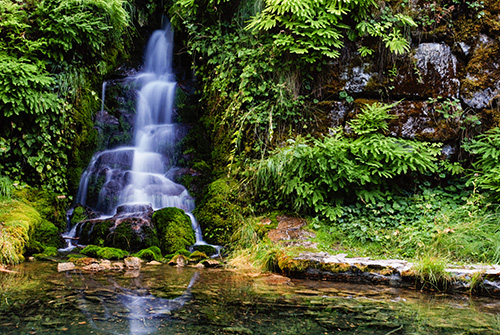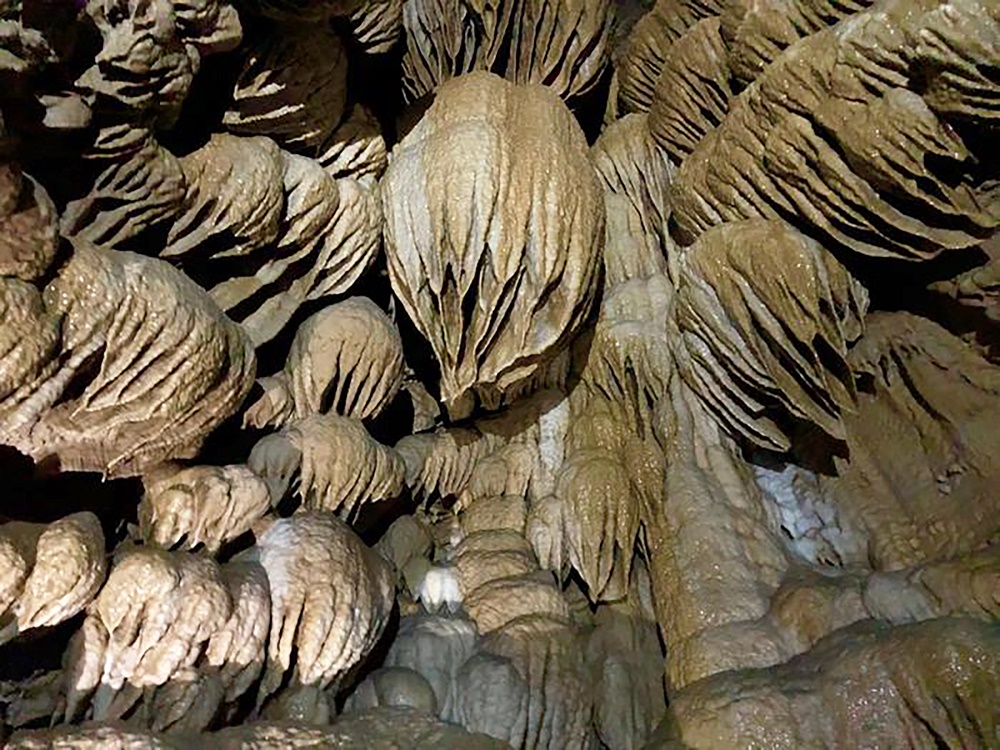Rare, Complex and Beautiful
 A cascade of water near the chateau at the Oregon Caves National Monument. (Oregon State Archives Scenic Images)
A cascade of water near the chateau at the Oregon Caves National Monument. (Oregon State Archives Scenic Images) Oregon Caves National Monument and Preserve is an often-overlooked jewel located southeast of Cave Junction in Josephine County. It is within the Rogue River-Siskiyou National Forest and managed by the National Park Service. The Oregon Caves and a surrounding area of about 484 acres were originally recognized and designated as a national monument by Presidential executive order in 1909. A complex geology, rich biodiversity, and one of only a few large marble caves in the Pacific Northwest combine to make this place of national scientific and public significance. A 4,070-acre national preserve was added to the monument in 2014 by Congress. The preserve protects the surrounding watershed that supports the caves, as well as old-growth mixed coniferous and deciduous forests.
The dark and winding passages of the Oregon Caves are found in southwest Oregon’s Siskiyou Mountains, a subrange of the more expansive Klamath Mountains. Although the size of the monument is relatively small, the range and complexity of the geology is large. Beneath the monument lies metamorphosed basalt, with smaller inclusions of argillite, metamorphosed diorite, quartzite, serpentinite, and peridotite. The Oregon Caves themselves are found in a large block of metamorphosed limestone called marble. The marble does not extend much beyond the area of the caves. It is an isolated block within a faulted mixture of igneous, sedimentary, and metamorphic rocks. Geologists call this group of faulted rocks the Rattlesnake Creek terrane. Granitic rocks of the Grayback pluton are the most common rock in the preserve and lie under the prominent 6,390-foot peak of Mount Elijah.
Limestone Transforms into Marble
Rocks of the Rattlesnake terrane, now part of the Siskiyou Mountains, were formed well offshore 200 million years ago as volcanic seamounts and seafloors. Limestones were likely reefs that formed next to the volcanic seamounts. The collection of rocks that hosts the limestone in the Rattlesnake Creek terrane is believed by many geologists to represent the remains of ancient submarine landslides or may have formed through faulting within a subduction zone as the terrane formed together and grew. All these features merged and were ultimately attached to western Oregon as plates underlying the Pacific Ocean collided with the North American Plate. About 160 million years ago, molten material of the Grayback pluton pushed into rocks of the Rattlesnake Creek terrane. The combination of the terrane coming together around 170 million years ago and intrusion of the Grayback pluton about 160 million years ago changed the limestone to marble.
 The magnificent Paradise Lost formation inside the Oregon Caves. Photo credit, National Park Service.
The magnificent Paradise Lost formation inside the Oregon Caves. Photo credit, National Park Service.
Oregon Caves began to form only about 1.7 million years ago when marble was near the surface and fractures formed in the rock. The caves grew as rainwater fell on the mountainous forests, percolated down through fractures, and the marble was dissolved by slightly acidic groundwater. This dissolution created the large underground passageways and rooms while the bedrock was beneath the water table. Oregon Caves contains a variety of cave formations which grow from the cave ceiling, walls, or floor as calcite minerals precipitate from water seeping through fractures. Calcite builds up over time to form cave formations like floor-rooted stalagmites and ceiling-hanging stalactites. The oldest of these cave formations, a flowstone from Neptune’s Grotto, is 370,000 years old.
Paleontologists examining sediment in the Oregon Caves have recognized many fossils of scientific importance. Remains of a 38,000-year-old jaguar, black bear, and 50,000-year-old grizzly bear have all been found. Cave sediments, with an abundance of fossilized remains, range in age from less than 10,000 years old to at least 120,000 years old; some may be as old as 1.5 million years.
Next:
Cascade-Siskiyou National Monument >